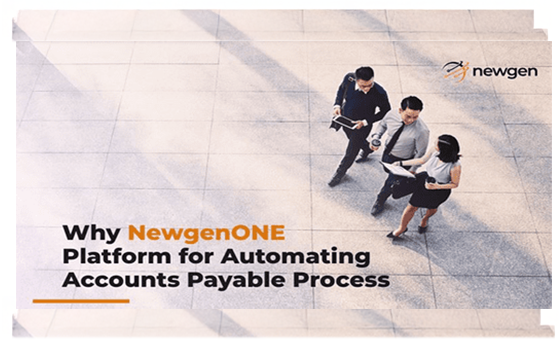Overview
Earlier, the finance team had to go through the laborious and error-prone manual account payable process. The conventional process required sorting stacks of papers, communicating with the approvers, and mailing checks, which was time-consuming. The solution to this problem is Account Payable Automation.
The Account Payable Automation process automates routine accounting tasks such as receiving invoices, coding, reconciliation and routing for approval payment using software tools. The account payable process of any organization has a workflow by which the team completes tasks in steps. This involves receiving invoices from customers, matching them with the goods or services received, recording the invoice in the company’s account system, obtaining approval from the authority, scheduling payments, and issuing payments. You can automate this lengthy process by using the accounts payable automation software. Let us look at the process in detail.
How AP Automation Works?
Account Payable Automation involves specific steps by which the finance department can perform the account payable operations with ease, so let us go through the process of how AP automation works:
- Invoice Capture with Optical Character Recognition (OCR) and E-Invoicing: The first step involves scanning the incoming invoices using OCR scanning technology. This step consists of scanning, recognizing, and capturing paperwork invoices and converting them to digital data. E-invoicing systems allow vendors to send invoices directly through electronic media; hence, there are no physical paper transactions.
- Matching and Verification: Once the system has collected the invoice data, it automatically verifies that the invoices match the relevant delivery receipts and by orders. In this way, the invoice items and the purchase terms align accurately. Automating this process ensures that only the accurate invoices move to the next level.
- Approval Workflow: AP Automation Software allows invoices to be automatically forwarded to the right personnel for approval quickly, depending on predefined guidelines. Automation will enable you to set up notifications and reminders, increasing the speed of approval and keeping all the actions documented throughout the process.
- Payment Execution: After the approver approves the invoice, the automation system streamlines the payment process by selecting the correct payment option, scheduling the payment, and executing the payment either manually or automatically. Automating your payment helps reduce early payment charges, guarantee timely settlements, and preserve good vendor relations.
- Reconciliation and Reporting: After payment, the system performs the automatic reconciliation process to match the amount and the recipient’s bank statements. Additionally, you get comprehensive data on the vendor performance expenditure trends and saving opportunities. Therefore, the financial team can make strategic decisions based on generated data.
Simply put, AP automation provides a smooth, coordinated, and organized method of managing the invoice-to-payment cycle.
Business Benefits of Implementing Accounts Payable Automation
AP Automation offers several benefits that contribute to improved business performance.
- Enhanced Efficiency: AP automation reduces manual efforts and accelerates invoice processing. Ultimately, it increases the organization’s productivity as the approval time is quick and error-free.
- Improved Financial Accuracy: Automating accounts payable reduces human error, thereby ensuring higher reliability and consistency. Accurate financial data helps in decision-making and builds trust with stakeholders.
- Tangible Cost Savings: Adopting AP automation will reduce the cost of managing human invoices, error correction, and late payments. It will also reduce the cost of paper storage requirements and shipping costs.
- Improved Financial Visibility: AP automation provides a clear summary of financial commitments and transactions, a consolidated picture of the complete payment process in real-time. Financial executives may make proactive decisions and develop strategic plans with such openness, which provides them with actionable knowledge.
- Enhanced Fraud Prevention: The automation has a feature that can predict abnormalities in transactions. When questionable behavior is flagged by built-in security and accountability mechanisms, fraud may be detected more easily. Organizations can proactively assess risks by improving security measures to protect their assets.
Challenges with Manual Accounts Payable Automation Process
As discussed in the above section, the traditional accounts payable process has inefficiencies and risks that can hinder business growth. Some of them are listed below:
- Time-Consuming Manual Data Entry: Manual data input is time-consuming and may be associated with delays in invoice processing.
- Human Error and Financial Discrepancies: Whether accidental or not, typing mistakes or repeatability of the same entry can result in fiscal misbalances and tense vendor relationships.
- Delays and Inefficiencies: The biggest drawback of performing AP manually is that the process takes longer than usual. Organizations, thus, often end up paying bills later than they should or miss out on early payment discounts that could bring down their expenditures.
- Difficulty in Tracking and Managing Invoices: Manual systems are non-transparent, and it becomes difficult to assess a given invoice’s updates and approval status.
AP automation provides an easy, paperless way to perform all your AP operations, free of errors and requiring less manual effort.
Top Accounts Payable Tasks to Automate
The finance team faces numerous challenges when dealing with large invoices, expense reports, and financial data. Due to economic conditions and market volatility, the need for automation, compliance, and efficiency is always higher. Let us look at the accounts payable tasks that can be automated to achieve better outcomes.
1. Automated Invoice Processing: Eliminating Manual Data Entry
Data entry in accounts payable is among the most time-consuming tasks. AI-powered automation extracts important data from invoices, such as vendor details, invoice amounts, and due dates, thereby reducing the need for manual data entry and eliminating the chances of human errors.
2. Automated Invoice Matching and Exception Handling: Preventing Errors
An AI-powered system can identify inconsistencies and prevent errors in invoice matching and exception handling. This automated matching method assists AP teams in upholding corporate policy compliance. AI systems may start exception-handling procedures when mismatches happen, alerting the appropriate parties and guaranteeing a prompt resolution.
When a vendor updates an invoice or a new vendor is added, AI solutions may learn from past data. This eliminates the need for templates and human updates, so conventional automation features don’t need reprogramming for any changes.
3. Automated Invoice Workflow: Streamlining the approval process
An automated system can streamline the invoice approval process. The system has preset rules and criteria that ensure that invoices move efficiently through the approval process. Finance directors may monitor the status of invoices and make data-driven choices to maximize cash flow with more visibility into the approval process.
4. Improved Supplier Relationship Management: Enhancing Vendor Partnerships
AP automation can help you review historical data. You can check and view the information to make data-driven decisions. You may get an idea about trustworthy suppliers, negotiate favorable items, and ensure timely payments.
5. Automated Expense Report Processing: Simplifying Employee Expenses
AI-powered solutions can speed up the filing of expenditure reports by classifying expenditures, automatically validating receipts, and ensuring adherence to corporate guidelines. This gives workers the authority to submit accurate and legal expenditure reports, resulting in more open and effective spending management.
6. Fraud Detection: Proactive Security Measure
Finance teams are always concerned about identifying fraudulent invoicing. An automated system might help by examining the trends and highlighting the anomalies. Thus, financial losses can be avoided, and security can be improved. AP teams can quickly investigate and take corrective actions when the system provides suspicious activity alerts.
7. Automated Forecasting of Cash Flow: Informed Financial Decisions
Cash flow forecasting is a crucial step in efficient financial management. AI can analyze past payment data and supplier behavior to produce accurate cash flow estimates. This helps businesses anticipate future cash flow issues, maximize working capital, and make wise financial decisions.
Best Practices for Implementing AP Automation
As we have discussed, automation in the accounts payable process ensures a reduction in cost, a streamlined process, and a good ROI in your organization. When carried out correctly, your efforts will significantly contribute to safeguarding your business’s financial future.
1. Align the AP Automation with the Business Objectives
Matching AP automation with business objectives will secure your business’s future success. It is necessary to identify the clear objectives of adopting automation in the AP process, as this makes it easier to evaluate the automation’s success based on clearly set goals and objectives.
2. Map out Workflows
Initially, mapping the existing system is crucial to enhance operations and produce outcomes. Workflows may have some exceptions; analyzing them is a necessary step to create barriers around the exceptions.
3. Discuss Any Improvement with Your AP team
If your staff isn’t on board, there’s no use in changing your accounts payable procedures and putting new technology in place. Without their knowledge, you won’t be able to determine if you’re dealing with the issue at its core. Make sure you’re developing the processes they require by consulting them early in the decision-making process.
4. Invest in Smart AP Solutions
Choose software that aligns with your business’s size, needs, and fiscal capacity. Check features such as OCR, AI, and analytics to choose the correct one. These features need to be incorporated to maximize performance and allow growth.
5. Get Leadership to Support Any Change
Changing any process and implementing new technology is always a challenge. You must take leadership to support and adopt this change. The team should be informed of the new changes in the process and how they will help reduce the inefficiencies in the current system.
How to Select AP Software?
Accounts Payable automation software may impact organizational financial performance. The common parameters that get positive results are correctness in data, efficiency in invoicing, and a time-saving account payable process. Therefore, organizations must choose the software that is in line with their requirements.
Let us go through the important parameters when choosing your AP automation software.
- Scalability: Check whether the AP software can fulfill your future requirements. It should be scalable with your business growth.
- Ease of Integration: Select the compatible solution that will easily integrate with your ERP system, financial tools, and other systems already in use.
- User-Friendly Interface: Choose software with an easy-to-use interface. This reduces the time it takes to master it, and you need not spend much time training your employees.
- Customization Options: Every organization has different requirements, so search for software tailored to suit your business’s needs.
- Vendor Credibility: Investigate software vendor reliability, customer services, and the company in general. You can check the reviews and ratings before selection.
- Costs: Check and compare the software costs from different vendors, including initial setup cost, potential upgrade cost, licensing, and maintenance fees.
Accounts Payable Automation with Newgen
Newgen’s accounts payable software helps you provide your accounting staff with more visibility and financial management. This AI-powered system can record, categorize, validate, match, approve, handle payment, and archive various invoice types, regardless of source, format, language, or location. It will maximize your investment return and ensure proper adherence to evolving regulatory requirements and service-level agreements.
To optimize straight-through transaction processing and guarantee first-time accuracy, you can choose Newgen as your AP Automation partner. You get several business benefits if you choose Newgen, such as increased efficiency, faster approval cycles, accuracy, cost savings, vendor management, and scalability.
Wrapping Up!
AP Automation is one of the significant transitions that help organizations improve their financial management and outcomes. With the help of advanced technologies such as artificial intelligence, businesses can enhance their AP operations, experience better control of cash flows, and have more effective relations with suppliers. Selecting the correct AP automation software coupled with proper implementation results in achieving greater operational expense and overall strategic value.
Frequently Asked Questions
- Can you automate accounts payable?
Yes, the accounts payable process can be automated with accounts payable automation software. You can automate the whole process from start to finish, i.e., from invoice to payment. AI-powered automation software also helps optimize the account payable process for maximum ROI, resource utilization, and time and manual effort savings.
- What is AP in automation?
Automaticity in the context of AP stands for the systematic application of technology in handling accounts payable. It encompasses automating functions like invoice recognition, data input, approval workflow, and payments. This offsets the time and energy involved in the manual handling process, cuts costs, and enhances efficiency.
- Use of AI in AP Automation?
AI can extract invoice data, match purchase orders, and even flag disparities in AP automation. It can also forecast cash needs and disbursement requirements and schedule payments accordingly. By making decisions based on learning from data rather than acting as a data-driven prediction tool, AI reduces decision-making errors and fraud.
You might be interested in

25 Oct, 2024
An Engineering Company in India Streamlines Accounts Payable Process with Newgen

31 Aug, 2023
Case Study: A Leading Dubai-based Company Transforms Accounts Payable Process with Newgen

18 Jul, 2024
Case Study: A US-based Leading Manufacturer in Metals and Materials Transforms its Accounts Payable Process with Newgen

